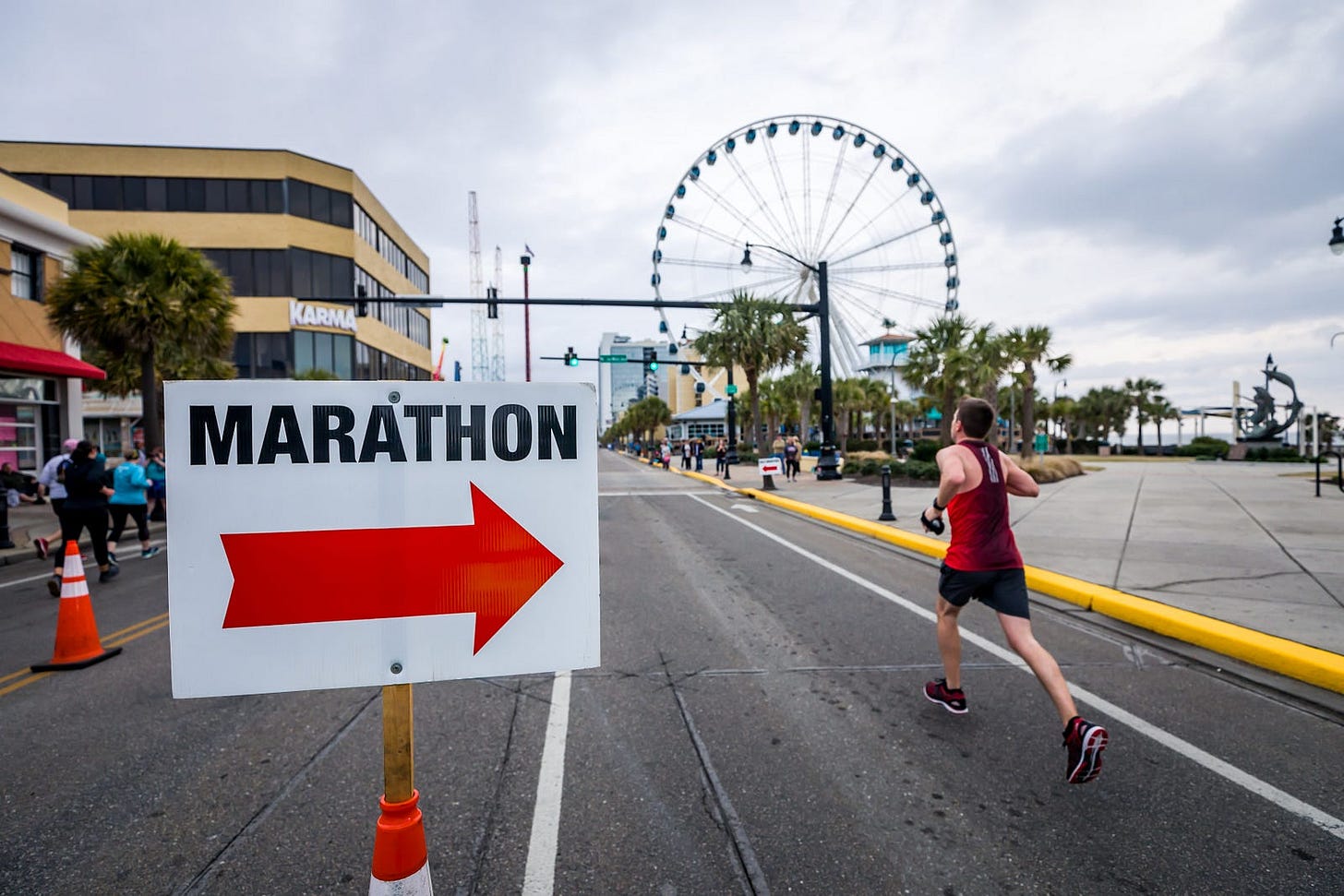You Just Gotta Put in the Time Bro
Patience is a virtue. You get better by putting in the volume, mainly easy, always fun.
I recently read the journal article Mundanity of Excellence, by the Hamilton College social scientist Daniel Chambliss. The article, which focused on swimming, relied on hundreds of interviews from athletes at all levels of the sport, as well as the personal experience as the author as a swim coach. Chambliss used this evidence to argue, as is probably given away by the name of article, that’s there’s nothing special about excellence: it is merely the stringing together of fairly easy individual tasks with strict regularity. Although I think Chambliss fails to give enough credit to genetic variation (certain body types and mindsets have a large genetic component), I generally agree with his argument. However, I do take issue with how Chambliss addresses the question of practice time, what I will be calling “volume” for the remainder of this essay.
It is not by doing increasing amounts of work that one becomes excellent, but rather by changing the kinds of work (p. 75)
the positive impact of yardage seems to come with huge increases e.g. the doubling of a workout distance — in which case one could argue a qualitative jump has been made (p. 73)
So is doubling practice time changing the kind of work, or the quantity? It seems pretty clear to me that it’s the later. So therefore is Chambliss’s first statement untrue? I found the way this was argued in the essay to be very frustrating, but I think Chambliss is getting at a real distinction here. Volume is not going to help you get better if you are fixated on doing the wrong things, but a). if you are doing the right things is the most important factor in long-term improvements and b). gives you more opportunities to notice and improve on things that you are not doing correctly.
I will attempt to provide support for these ideas from 3 areas of my life (running, language learning, and science), as well as to expose nuances in how volume impacts performance in these different fields
Running

Long, slow volume is really good for aerobic development and thus performance at any race distance over four minutes or so. Like really good: increases the number of mitochondria you have in your muscles, increases fat and sugar oxidation efficiency, increases blood volume, and in the long term increases your lung’s oxygen capacity and heart’s stroke volume. There’s probably even more adapations that I’m forgetting about here. And by doing this volume easy, you are drastically decreasing the likelyhood of injury or illness due to overtraining.
Most running coaches I’ve had have acknowledged the importance of volume. Both my highschool and college coaches were self-professed followers of Arthur Lydiard, who was one of the original proponents of high-volume training in starting in the 1940s. However, in practice, my training was never really encouraged to be high-volume. When things weren’t going well, one of the first moves was always to cut back on training volume, rather than on workout intensity. My college coach also had some strange ideas about appropriate easy intensity: he had us train by heart rate, but then would shame us for running slower than 7:30 pace, even if that’s what the heart rate demanded.
Despite the lack of encouragement from coaches, I still often managed to fit in high-volume weeks over the summer and in the fall during the cross country seasons of 2015,2016, 2018 and 2019. Since my coaches were afraid of me doing too much mileage, I biked or swam to increase volume, since many of the aerobic adaptions are actually quite similar. So even though it looked like I was running 25:20 in the 8k on 35 miles a week, I was really doing about 8–9 hours of aerobic exercise a week. My real best seasons, 2015 and 2016, were built off of closer to 12 hours a week of training. This winter, with the help of a bike trainer, I’d like to get up closer to twenty. This may seem like a pretty impossible number to reach, but the average American watches around 3 hours of tv a day. Just throw that TV on while you’re on the bike instead.
There are a number of dangers in attempting to build running volume. I have experienced a few of them.
The first, and most obvious is injury. If you’re increasing the load on your bones, muscles and tendons without appropriate buildup and breakdown cycles (to allow your body to grow stronger), you will get injured. This happened to me in both 2018 and 2019 after I had to stop training for ~2 weeks and tried to immediately come back to the mileage I was doing. I immediately got reinjured.
Another risk is too much intensity. In 2017, after a dissapointing track season, I tried to have the summer of my life in terms of training. I was training ~15 hours a week and working ~40, as well as trying to have a social life. This probably would have been fine, but I was pushing a lot of the training. In early July I got sick, and by August and for the rest of the fall I was toast. In hindsight, I probably could have handled the volume I was subjecting myself to without all that intensity, and still managed to have a great cross country season in the fall.
A final risk with running volume is not recovering properly. Lack of sleep, drinking, and poor nutrition will all prevent your body from making the adaptions necessary to improve.
One final note that I want to make. A lot of the effects of volume are cumulative over ones lifetime. This means I can still rip out a sub 17 5k with one week of real training a month after having COVID. But this does not mean my lifetime volume alone will propel me to running fast. I learned this during the cross country season of 2021, and during the past year, where I’ve tried to skate by on low volume. Perhaps Chambliss is correct fundamentally: high-volume training is a lifestyle. One that it’s time to return to.
Language Learning

I’m a believer and practitioner of the Refold1 method of language learning, which emphasizes the importance of input based learning. Input in this case means any media in the language: books, TV, video games, movies, podcasts, etc. How much input? Just an episode a week on top of your “real” Spanish class where you study? Nope. Pablo from Dreaming Spanish, a YouTube channel dedicated to producing only-Spanish input at a variety of different levels, hypothesizes that you need about ~3000 hours of input to get to the level where it’s comfortable to talk to a native speaker. At an hour a day, this would take about 8 years. As a full time job, 8 hours of practice a day, it would take about a year to reach this level of input.
How do we know that this isn’t just a crazy idea from some YouTuber? The scientific consensus in linguistics, centered around the work of Steven Krashen, also agrees that the input hypothesis is true: we learn languages by comprehending messages. This also makes sense from historical perspective. How did people used to learn foreign languages2: by immersing themselves in the community of the speakers, often through necessity, or for the more upper-class, reading.
I’ve also personally observed that input-based immersion works. I’ve immersed in native Spanish media for nearly 1200 hours, and have noticed my abilities improve from being able to barely able to understand the first Harry Potter book to being able to read untranslated fantasy epics such as Olvidado Rey Gudu, and to talk with tutors on iTalki about quantum computers, philosophy, and degrowth. However, that is not to say that I still don’t have a ways to go, or don’t need practice speaking explicitly. That itself is another question of volume
Unlike running, there aren’t as obvious downsides to immersing more, although they still exist . I have been trying to do as much of my reading and listening in Spanish as is possible, replacing most of my for pleasure, degrowth, and philosophy reading with works in Spanish. However, I have found that this has diminishing returns: I’ll get tired after a few difficult hours of reading in Spanish, and forcing myself to keep reading usually ends up turning into surfing the web instead. I suspect this amount of time can be increased with meditation, and curing my internet addiction, but this remains to be seen.
Science

I actually read the Mundanity of Excellence at the recommendation of my faculty advisor, a professor in biology, and as deeply immersed in the world of academia as Chambliss. While the paper is *mainly* about swimmers, there is also some emphasis on the world of academia in which the author inhabits. Here volume is a little more tricky of a question.
“The same pattern holds true in academic life. The leading figures of a discipline are not those who’s quantity of production is so high — although that may give an added advantage to those who are widely read — but those who write the quality, or kind, or article and books are widely read and talked about” -Chambliss, Mundanity of Excellence, pg. 75
Simply working more in the world of science, even if you are doing what Walter Kaufman would call “Scholasticism”3 — the investigation and solidification of the theories of other visionary scientists4, does not produce more results. I’ve learned this first hand. There’s a limit to the amount of time I can put in in the lab each day before I start making mistakes in my experiments, or finding my attention drifting away from what I’m supposed to be writing or coding. Again, this may be improved by curing my internet addiction and practicing meditation, but even if I do both of those things, a hard limit to the amount of time I can spend in the lab productively still exists.
The problem then, in science, seems to be how to use the volume we have well. Chambliss takes a pretty vague stance on this, merely implying that we have to focus on quality rather than quantity of papers. His argument reminds me a lot of Walter Kaufmann’s emphasis on visionaries, people like Einstein, Darwin, or Galileo, who really move our understanding of the world forward, as opposed to scholastics, who are merely expanders or catalogers. However, Kaufmann rightly notes that most people don’t have it in them to be really true visionaries. What then is the right path for the average scientist to take with their limited brain-time?
I don’t pretend to be an expert, I’m merely a fourth year PhD student, but I have some ideas. We may not all have it in us to be visionaries, but scholastic science has produced many advances and refinements of the work of those visionaries that we wouldn’t be here today without. For every Newton, we need thousands of engineers and architects to put his work to use, and hundreds of scientists to make incremental advances on his theories, not to mention the scholars to teach those professionals. This may suggest that what we need is specialization, focusing on a very narrow aspect of some visionary’s work. However, there is danger here too, of becoming what Ortega y Gasset would call a “señorito satisfecho”5 who is unable to participate effectively as a citizen in society at large because he is so hyper-specialized. You can clearly see the results of this today in the decline of interests in our civic institutions, and the lack of interest in the details of science, and other academic subjects, rather than the religion that those said subjects have become.
What I would propose instead for the scientist, and what I’m trying out myself, is a two-tiered model of high-volume general knowledge development, reading books and papers outside your field, and lower volume of intense focus on one topic in particular. If you like, you could consider the two tiers as being continuous, sliding into one another like a pyramid rather than two steps. This model is rather like how I think running training should go: lots of low-volume aerobic development with a little race specific preparation. What does that look like in science? I think a lot more reading, a lot less experiments, and above all, patience. Greatness comes with time.
I hope you’ve enjoyed this article: it’s been a long one in the making! I hope to get back to a more regular posting schedule now the semester has settled down a little.
https://refold.la
I realize that this may come off as a little US-centric. Many people in parts of Asia, Africa and the Americas still do learn languages in this way
See Kaufmann’s The Future of the Humanities
For what it’s worth Ortega y Gasset endorsed this view as well.
See the Revolt of the Masses





Really great article. I am reminded of the speed skating training plan which is also a very valuable guide not just for training speed skating, or even for other sports, but for mastering anything in life. The training plan emphasizes (1) total volume/time spent, (2) spend the time on what helps you improve the most, (3) knowing your capabilities and limits, and gear your program around what will work for you.
Volume seems like it will always help you improve more. It's hard to think of any activity where more volume would not help. It reminds me of how increasing the amount of computation always improves neural network performance.
https://www.howtoskate.se/_files/ugd/e11bfe_b783631375f543248e271f440bcd45c5.pdf